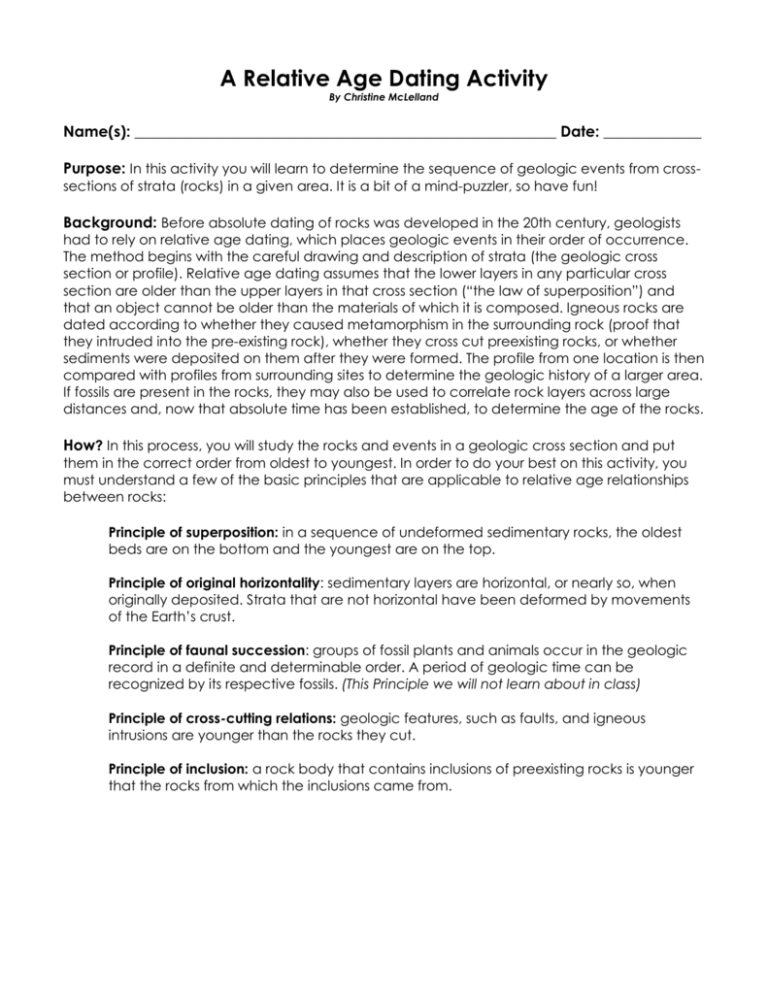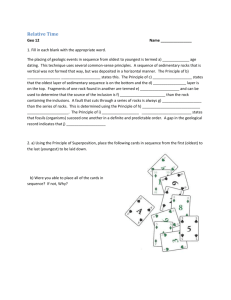A Relative Age Dating Activity By Christine McLelland Name(s
advertisement

A Relative Age Dating Activity By Christine McLelland Name(s): ________________________________________________________ Date: _____________ Purpose: In this activity you will learn to determine the sequence of geologic events from crosssections of strata (rocks) in a given area. It is a bit of a mind-puzzler, so have fun! Background: Before absolute dating of rocks was developed in the 20th century, geologists had to rely on relative age dating, which places geologic events in their order of occurrence. The method begins with the careful drawing and description of strata (the geologic cross section or profile). Relative age dating assumes that the lower layers in any particular cross section are older than the upper layers in that cross section (“the law of superposition”) and that an object cannot be older than the materials of which it is composed. Igneous rocks are dated according to whether they caused metamorphism in the surrounding rock (proof that they intruded into the pre-existing rock), whether they cross cut preexisting rocks, or whether sediments were deposited on them after they were formed. The profile from one location is then compared with profiles from surrounding sites to determine the geologic history of a larger area. If fossils are present in the rocks, they may also be used to correlate rock layers across large distances and, now that absolute time has been established, to determine the age of the rocks. How? In this process, you will study the rocks and events in a geologic cross section and put them in the correct order from oldest to youngest. In order to do your best on this activity, you must understand a few of the basic principles that are applicable to relative age relationships between rocks: Principle of superposition: in a sequence of undeformed sedimentary rocks, the oldest beds are on the bottom and the youngest are on the top. Principle of original horizontality: sedimentary layers are horizontal, or nearly so, when originally deposited. Strata that are not horizontal have been deformed by movements of the Earth’s crust. Principle of faunal succession: groups of fossil plants and animals occur in the geologic record in a definite and determinable order. A period of geologic time can be recognized by its respective fossils. (This Principle we will not learn about in class) Principle of cross-cutting relations: geologic features, such as faults, and igneous intrusions are younger than the rocks they cut. Principle of inclusion: a rock body that contains inclusions of preexisting rocks is younger that the rocks from which the inclusions came from. Here are some additional hints that will help you with your diagrams: Sedimentary rocks: If rocks are folded, the folding is younger that the youngest rock affected. If they are folded into a syncline (a U-shaped fold) the youngest rocks are in the core of the fold (see figure B). The opposite is true for an anticline (a big dome-shaped fold). Sedimentary rocks that contain fragments of another rock are younger than the rocks that the fragments came from. Figure B. Oldest rocks: A, followed by B, C and D. All four sedimentary layers were folded into a syncline. Layers E and F were then deposited at a later time and are the youngest. Igneous rocks: Are formed by the solidification of a liquid magma; the therefore can intrude into preexisting rocks or be poured out onto the surface of the earth. If an igneous body crosscuts another rock, the igneous rock is younger than that rock (see Activity figures 1 & 3). If a body of granite contains unmelted inclusions of another rock, the granite is the younger rock. Remember! Granites can intrude into other rocks, even though they may be on the bottom of your geologic diagram. Look carefully for the granitic pattern (see below) and for irregular contacts between the granite and the country (pre-existing) rock (see Activity figure 2). The granite may also metamorphose the country rocks: o Intrusive rocks produce contact metamorphism (shown as a starred pattern within the country rock pattern, see Activity figures 2 & 3) along their contacts with the older rocks they intrude into. o Lava flows may cause contact-metamorphism with the older rocks they lie upon. Metamorphic rocks: Are pre-existing rocks that have been metamorphosed (changed into different rocks) by large amounts of heat and pressure in a region. These rocks have usually been deformed by large, mountain forming events, and therefore if they are in contact with layered or unmetamorphosed rocks, they are usually the oldest rocks in the sequence (considering that if those rocks had been in place when the metamorphism occurred, they also would be metamorphosed!). Always look for the metamorphic pattern to determine if there is a metamorphic rock in your sequence. Metamorphic rocks are older than sedimentary rocks deposited above them or with igneous rocks that may intrude them. Procedure: Part 1: Answer the following questions based on your reading from above: 1. Which of the principles apply to sedimentary rocks? 2. Are only sedimentary rocks used for relative age determinations? Explain: 3. Explain the relative age relationship of faults to the rocks they cut: 4. Look at the diagrams in Part 2 below and answer the following: (a) In figure 1 below, could it be possible to determine an absolute age of these rocks? If yes, explain in detail how you may be able to do this: (b) In figure 3 below, could it be possible to determine an absolute age of these rocks? If yes, explain in detail how you may be able to do this: 5. How do you determine the relative ages of igneous rocks? (List the ways) Part 2: For each of the following cross sections, determine the relative age sequence of the rocks. Place the answers in the spaces on the right. Remember, always start by looking for the oldest rock first and working your way from oldest to youngest. Don’t forget to consider all intrusions and faults! The diagrams go from simplest to hardest to let you progressively improve your skills. Briefly explain the geologic history in the area from Figure 4:





